Integrating with VSA 9
Introduction
Use this article as a guide to create and maintain an RMM integration with VSA 9, an RMM solution. This gives you information about CPU, memory, disk usage, last reboot, etc.
To integrate with Kaseya BMS, see Integrating with Kaseya BMS instead.
It should only take about an hour to get up and running with your RMM. This is a rough estimate based on our experience with several partners who integrated with their RMM.
NOTE Personal Access Tokens (PAT) were introduced in VSA to replace basic authentication – username and password combination – for API connections. Basic authentication has since been deprecated and will be removed from VSA.
The Kaseya sync described below will do the following:
- Discovers all orgs and machines in Kaseya
- Matches Kaseya orgs to organizations in IT Glue using the Kaseya Org Name field
- Suggests organizations based on name and pattern recognition
- Matches machines to configurations in IT Glue using a MAC address or serial number
- Suggests configurations based on exact name
- (Optional) Machine group matching
Used to match machine groups to sub-organizations in IT Glue
For more information about the device mappings, see RMM field mappings.
Prerequisites
- Manager or Administrator level access to IT Glue.
- An SSL connection with a valid certificate chain, including an intermediate certificate signed by a trusted authority is required. The following are the certificate requirements:
- Certificate must be signed by a valid issuer (not a self-signed certificate).
- SSL chain including the intermediate certificates must be complete.
- The FQDN for the server hosting the RMM instance must match one of the certificate's common names.
Note: Use an online SSL checker such as SSL Shopper to check your certificate status.
- If you're integrating with a PSA and an RMM, you will want to first sync your RMM to your PSA and your PSA to IT Glue to make sure that the required data is available for matching.
- For On Premises deployments, you must be running VSA 9 version 9.5.0.12 or higher.
- A dedicated Kaseya user account with "Master" or "System" role and scope.
- A Manager role will only be able to see RMM matched/unmatched data for organizations that they have explicit access to. To grant access to RMM data for all organizations, refer to Step 7 of our Adding and removing users topic.
Instructions
Configure RMM
IT Glue talks to Kaseya via API to monitor for devices so we can perform our routine sync. The steps for creating an account are below:
- Log in to Kaseya and navigate to System > User Security > Users.

- Click New.

- Complete the fields, ensuring the fields highlighted below are completed as suggested. Click Save.
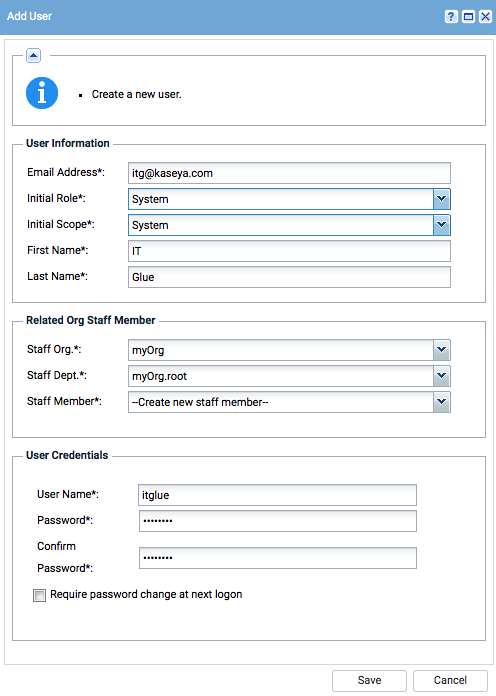
- Login to VSA again to activate the user account before you carry on with the integration.
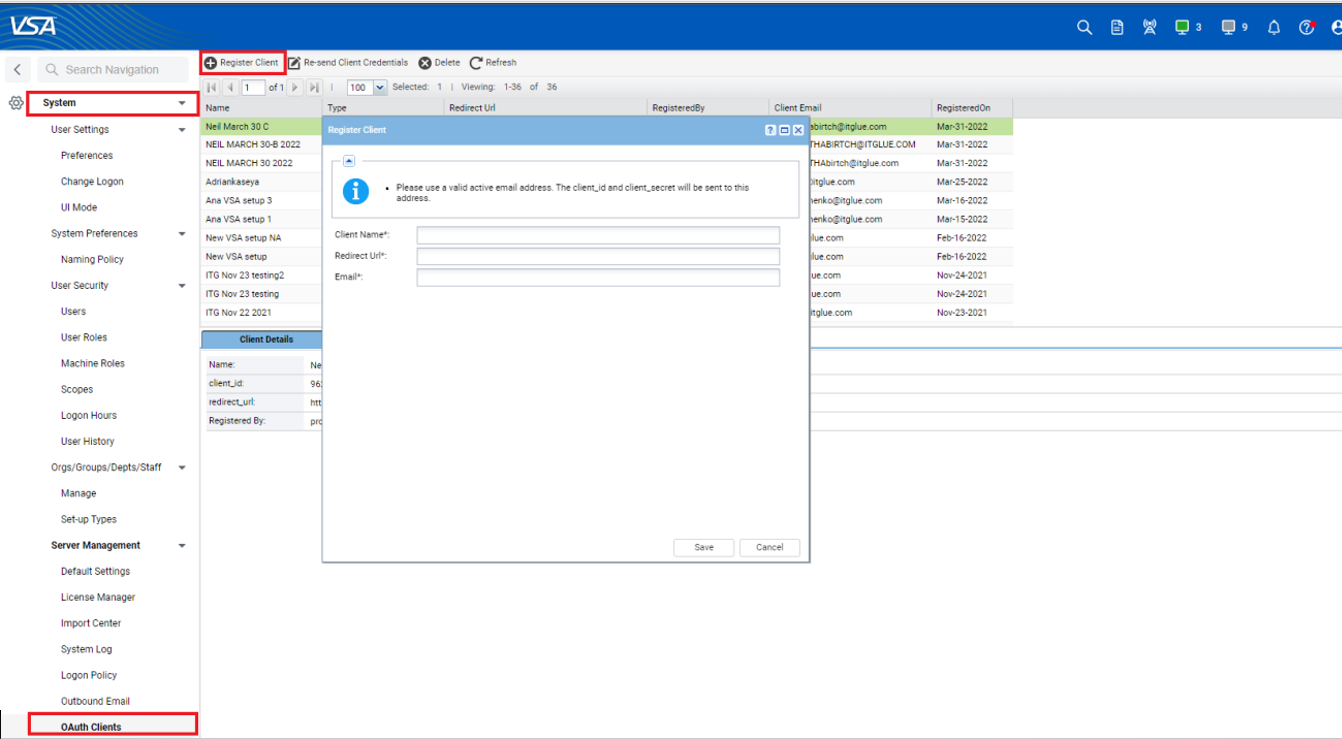
For more information on setting up agent procedure in VSA 9, see Executing VSA automation in IT Glue.
NOTE The Kaseya user created above should only be used for integration purposes. If filters are applied in the Kaseya asset list, IT Glue will not pick up all assets. If this username has been used to log in, please make sure all filters are cleared on the asset list.
Enter your RMM credentials
- Log in to IT Glue and navigate to Account > Integrations. Then, click on the green + New button and then on the Kaseya icon.
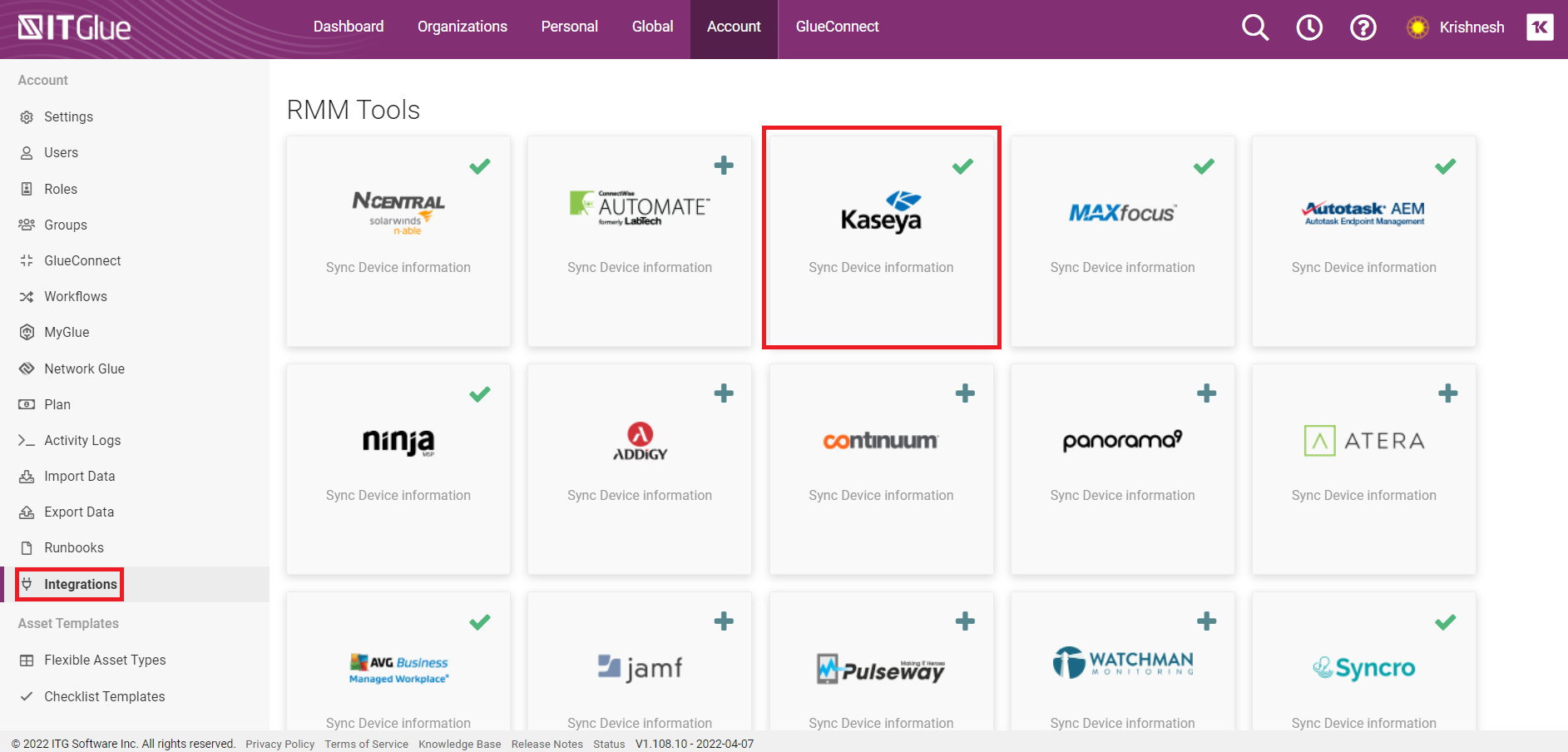
- Enter your Kaseya Fully Qualified Domain Name (kaseya.example.com) and email address of your Kaseya credentials. Then, click on the Connect button. To add a custom port for API traffic, you can add the port to the FQDN. For example, to add port 3000, your FQDN would look something like: kaseya.example.com:3000.

- After you enter your RMM credentials in IT Glue, you will need to match your IT Glue Organizations to either Orgs or Machine Groups.
Option Description Orgs
Matching on orgs will allow you to match to top-level organizations in IT Glue.
Machine Groups
Matching on machine groups allows you to match to organizations and sub-organizations in IT Glue.
You can change this preference at any point. If you change your preference later, existing matches will be reset. For more information about sub-organizations, see Working with sub organizations.
- Select the Enable access from Kaseya VSA checkbox and click Save.
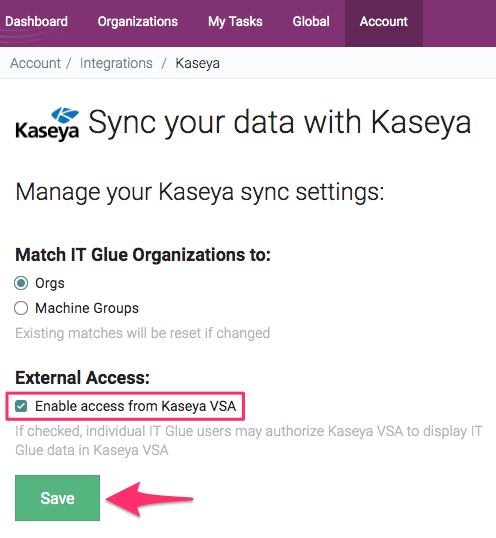
NOTE Note 1: If the credentials fail for any reason, syncing will stop until you re-enter your credentials.
NOTE Note 2:The user account used to integrate VSA with IT Glue cannot have MFA/2FA enabled via AuthAnvil. If it does, the sync with IT Glue will not work. VSA native 2FA does not affect the integration. If the user is whitelisted using the whitelist exclusion list in AuthAnvil then the user will be able to login to their VSA using the IT Glue user credentials (email address) without being prompted for MFA.
NOTE Note 3: Enabling this integration may result in activity logs from Kaseya data center IP addresses.
Sync Data
- From the Account > Integrations screen, click Actions > Start Manual Sync.

- When the sync is complete, the Status column changes from Syncing... to OK.
Organization matching
IT Glue discovers organizations and configurations and tries to match them to data in your account. The matching logic can be found in the Introduction section of this article. Anything that isn't automatically matched will need to be manually actioned.
- From the Account Integrations screen, find your RMM in the list and click on Actions > Matching.
- In the Unmatched tab, review the unmatched organizations.
- If you're happy with a suggested match, click Accept Suggestion to accept it.
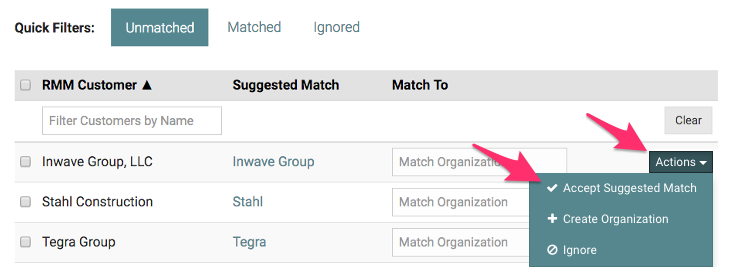
- If there is no suggested match, or it is incorrect, you can search for and choose a different organization using the Match To field.
- If no organization exists in IT Glue, you can choose to create an organization. You can also choose to ignore groups, which means they won't count as unmatched items in subsequent syncs.
IMPORTANT Warning. Before creating an organization from the matching screen, ensure that no corresponding organization already exists, otherwise a duplicate will be created.
- If you're happy with a suggested match, click Accept Suggestion to accept it.
- If any matches are incorrect, click on Actions > Change Match and select a different organization to match to.
Configuration matching
Once all organizations have been matched, the same process should be followed for any unmatched configurations.
- From the Matched tab, choose any organization that has unmatched configurations, click the Actions button, and select Match Devices.

- For any unmatched configurations, you can either accept the suggested match, search for an IT Glue configuration by entering the name in the Match To column, or create a new configuration by clicking Actions > Create Configuration.
- Before you create configurations, first match any of the devices based on MAC addresses or serial number, for example, virtual servers. When you're done matching, you can create (in bulk or individually) any of the remaining devices coming in from your RMM.
IMPORTANT We don't recommend that you create configurations from your RMM if you'd like to then have them populate from IT Glue to your PSA. New items created from such data will not sync with your PSA unless you choose to do so manually by editing and saving each and every item. This is absolutely manual and is not recommended.
- Repeat for each organization until all configurations are actioned.
Once everything is matched, the RMM setup is complete. At any time, you can come back to these instructions to discover and match new organizations and configurations from your RMM.
Enable Access From Kaseya (Optional)
Enabling access from Kaseya allows Attachments, Passwords, Related Items, Recent Versions and Notes from the corresponding IT Glue asset to be viewed directly in Kaseya.
- From this Kaseya KB, follow the steps listed after Figure 5.
- Click Actions, Sync Settings next to the Kaseya integration.

- Check Enable Access From Kaseya, and click Save.

IT Glue data should now be visible from Kaseya as described above.
NOTE If the error below is displayed when saving:
- On Premises - An intermediate / chain certificate likely needs to be installed on the Kaseya server. You can check certificate status by entering the Kaseya server hostname in to an SSL checker. Please take a look at the Kaseya article about using an existing SSL certificate for more information on configuring the certificate correctly.
- Cloud Based - Your FQDN needs to be updated by removing -cdn

RMM logic
Before an organization, site, location, or company in an RMM tool can sync with IT Glue to create an IT Glue organization, you must add at least one configuration to it. If there are none and the organization does not already exist in IT Glue from any other source, then it will not appear in IT Glue. In this case, you will need to create it manually.
Only RMM companies that have at least one RMM record will sync into IT Glue.
VSA Agent Status on Network Diagram
For our partners with Network Glue and an VSA integration, you can view and filter for all agent statuses on your network diagram. If your Network Glue devices are matched to IT Glue Configurations and synced with VSA 9, your diagram will show the following statuses:
- VSA agent is currently online
- VSA agent is currently offline
- VSA agent and user are both currently online
In addition, you can also filter for devices that are either matched or not matched to IT Glue through the "Matched to IT Glue" status.
For more details on this feature, refer to our Guide to Network Glue network diagram topic.



